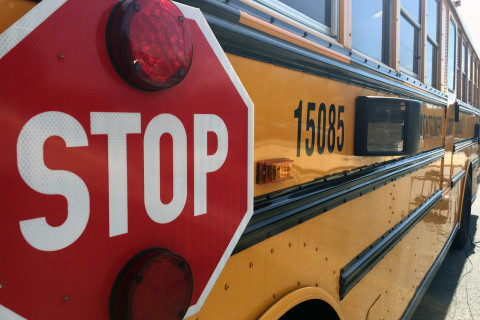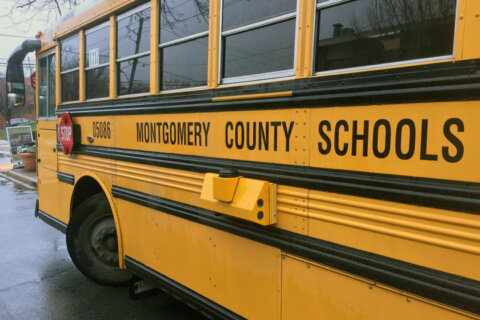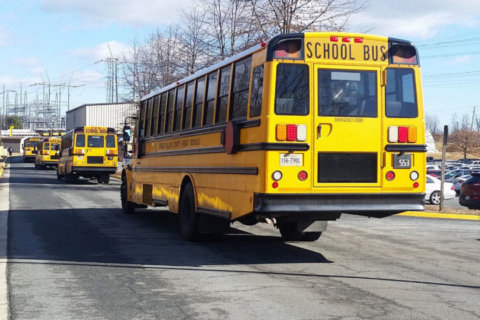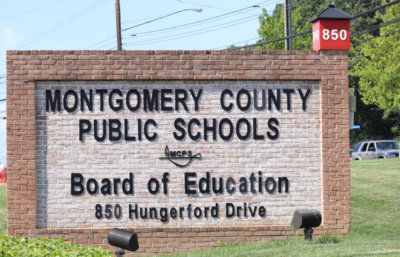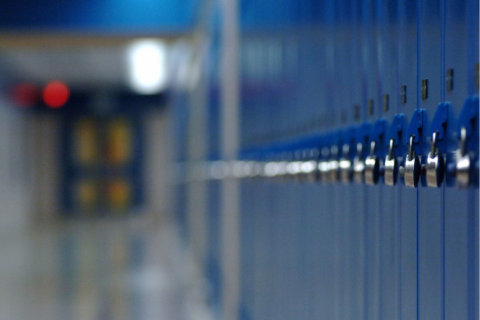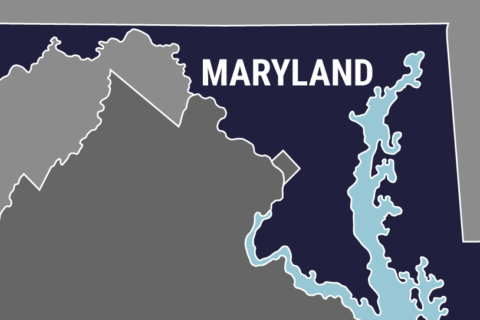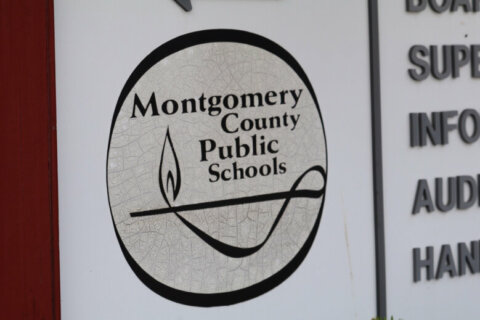WASHINGTON — Maryland public school enrollment continues its rocket-like trajectory — numbers have increased every fall since 2008. And, for the 2018-2019 school year, the system is poised to top 900,000 students for the first time in state history.
That many kids presents its own set of challenges, but as schools opened their doors Tuesday, Maryland said it was up to the task.
The state has also been working hard to bolster its position as a leader in education.
“Our schools are going to have another new record enrollment toll this year,” Bill Reinhard, director of communications for the Maryland State Department of Education, told WTOP. “Some of our schools are quite literally bursting at the seams.”
To contend with that, the state has been building — and continues to build — new facilities.
“We’ve had a number of new schools built,” Reinhard said. “They continue to be built, especially [in] Montgomery County, Howard County, Anne Arundel County — the region between D.C. and Baltimore.”
Maryland has some of the largest school systems — the biggest in Maryland being Montgomery County (over 150,000 students), followed closely by Prince George’s County (over 134,000 students) — in the U.S.
The reason, Reinhard said, is because they have county-based districts, plus Baltimore city. Most other states have smaller jurisdictions.
“These are large systems,” Reinhard said.
New year, new schools
Five new schools debuted in Maryland Tuesday.
Two are in Frederick County (Butterfly Ridge Elementary and Urbana at Sugarloaf, one is also being renovated). The others are in Baltimore, Howard (Hanover Hills Elementary School) and Montgomery (Bayard Rustin Elementary School) counties.
“One of the things that has been difficult for a lot of school systems has been keeping up with the demand or keeping their facilities prepared for the modern world,” Reinhard told WTOP.
“So many of our facilities were not built for the number of computers, or perhaps the number of career-in-technology education classes that require high-tech facilities.”
That is one of the things that Maryland is moving toward.
“The governor (Larry Hogan) has provided more money for school construction. … And, I think our school systems are really trying to jump right on that, making sure our students have the best facilities available,” Reinhard said.
New bus and transportation app for Prince George’s Co. kids
As students in Prince George’s County head back to school, the county is rolling out a new, free smartphone app called Here Comes The Bus, which uses GPS to track school buses in real-time.
“You’ll be able to see where the bus is, similar to the Uber app, where you can log on and see, ‘Oh, my bus is right around the corner,’ or ‘Oh, I missed my bus,'” John White, public information officer for Prince George’s County Public Schools, told WTOP.
“But, hopefully, that doesn’t happen too often.”
White said the app allows parents to call if they have a concern about transportation, such as a missed bus. The app tracks multiple buses if the children of a family don’t all ride the same bus.
New immunizations for students
The Maryland Department of Health has several new immunizations that incoming students are required to get.
- All students entering kindergarten and first through fourth grade must have had two varicella (chickenpox) vaccinations before the first day of school.
- All students entering seventh, eighth, ninth and 10th grades must have had one Tdap (tetanus, diphtheria and whooping cough) vaccination and one meningococcal (Neisseria meningitidis bacteria, MCV4) vaccination before the first day of school. They must also have a single dose of meningococcal (MCV4) vaccine before entering school.
- There are medical and religious exemptions to these rules. For more information, see the MDH immunization page.
Safer schools, safer students
One topic on everyone’s minds — locally and nationally — is school safety.
Following the death of 16-year-old Jaelynn Willey at Great Mills High School in St. Mary’s County in March, Maryland has taken particular steps to bulk up security at its schools.
Efforts range from the Maryland Safe to Learn Act, which Gov. Larry Hogan signed into law this year, to an increase in school resource officers (SROs), the state’s spring School Safety Summit, to the website safeschoolsmd.org, which offers resources for students and parents.
“A lot of the new construction money is going into building safer schools — or retrofitting schools that have previously been built with an eye on safety,” Reinhard said.
Charles County Public Schools, for example, have gotten security upgrades. Those upgrades were prompted by the case of Carlos Bell, who worked as a coach at several county schools and as a teaching assistant at Benjamin Stoddert Middle School between 2014 and 2016. He was convicted of coercing children into performing sex acts with him, in order to produce child pornography.
“As good a job as we thought we were doing with school safety and security, once that incident happened, all bets were off,” Superintendent Kim Hill said at a recent town-hall meeting at St. Charles High School in Waldorf.
“We took a whole new, fresh look at school safety and security.”
Maryland is also making school safety grants available to districts this year.
“We’re going to certainly take advantage of that,” White told WTOP. “Whether we use it to add staff or add technology, we want to make sure all of our schools are safe and secure.”
One of the tools the Department of Education is using to improve school security is the Maryland Center for School Safety. The center is housed with the MDSE but works closely with Maryland State Police.
“That has provided a lot of professional development for local administrators and school safety experts,” Reinhard told WTOP.
“We have brought together literally hundreds of educators and administrators a couple times a year to look at the latest and greatest in improvements for school safety. And, quite honestly, we feel that our schools are at the cutting edge of that as well.”
School resource officers are a big part of safety plans for Maryland schools.
“We have [about] 1,450 schools in Maryland and virtually all of our high schools have school resource officers,” Reinhard said.
In Prince George’s County, “All of our high schools have a school resource officer plus a school security team provided by the school district,” White said.
According to Reinhard and White, SROs are also prevalent at middle and elementary schools throughout the state, much like Virginia.
“We think the benefits have been tremendous,” Reinhard said.
While some of the particulars come down to the needs of the school — Baltimore City Public Schools have their own police force — Reinhard describes the relationship between schools, students and police as a partnership. And, he stressed that SROs are accessible to any student.
“I know when my own kids were in school, they all knew the school resource officers,” he told WTOP.
For Jack Smith, superintendent of Montgomery County public schools, safeguarding student safety meant a proactive approach to supporting physical, psychological, and social health.
“We’re going to be more vigilant, all of the adults in school need to be in the hallways outside paying attention,” Smith told WTOP. “When a student is troubled and having problems in class and in the school day, we need to intervene sooner so those levels of frustration, depression, anxiety, and anger don’t reach the level where students act out and strike out against others.”
AMP, P-TECH and expanded opportunities for students
As one might have guessed from the name, P-TECH (Pathways in Technology Early College High schools) is one of Maryland’s career and technology programs. It has been championed by Hogan.
The program will welcome its first group of students at Dundalk High School in Baltimore County and Clarksburg High School in Montgomery County. (P-TECH has already been in place at Paul Laurence Dunbar and Carver Vocational Technical high schools in Baltimore City, Allegany Career and Technology Center in Allegany County, and Frederick Douglass High School in Prince George’s County.)
“P-TECH involves providing students a couple of years of technology education at the high school level and moving on to two more years of technology education at a postsecondary level at a community college or a technical college,” Reinhard told WTOP.
“A student is able to combine that education and really come right out with a job and an associate degree and really a leg up when it comes to hiring.”
Those jobs exist thanks to industry partners who, if they don’t hire the students directly, know of other companies in the field who need to recruit talent.
“We want to make sure that the business community is ready for us as well, so we’re also looking for more partners,” Reinhard said.
According to Reinhard, the program — developed by IBM — has seen a lot of interest from both students and parents.
“It really falls in line with other things we’re doing,” Reinhard said.
Also new this year is the implementation of the Apprenticeship Maryland Program (AMP), a partnership between MSDE and the Department of Labor, Licensing and Regulation, which is designed for students age 16 and up.
Through it, eligible employers can hire high school juniors and seniors for particular jobs in manufacturing and STEM industries.
“The idea is really to create a clear path so a student isn’t confused about what [classes] they have to take in order to join that career field,” Reinhard said.
White, with PGCPS, said the program helps fill the needs of the people in the county.
“We have a lot of people in our community who are asking, ‘What happened to the trades? We need our students to learn skills,'” he told WTOP. “And, we agree with them, and we’re trying to take our career programs a step further with the apprenticeships.”
As with P-TECH, AMP has generated lots of interest from students and parents. A pilot version of the program last year in Frederick and Washington counties worked out “very, very well,” according to Reinhard.
He was quick to point out that AMP does not in any way preclude a student from going to college. Rather, the point of the program is to provide more opportunities.
“We don’t want to say there’s one single path to success. A student’s path to success may be somewhat different than the child next door’s,” Reinhard told WTOP.
“Everybody deserves that opportunity,” he said.
WTOP’s Melissa Howell and Alejandro Alvarez contributed to this report.


